The Concept of Intelligence: A Psychological Perspective
VerifiedAdded on 2023/06/13
|10
|3049
|93
AI Summary
This article discusses the concept of intelligence from a psychological perspective, including its definition, origin, relevance, and measurement. It also explores popular theories related to intelligence and their validity and reliability.
Contribute Materials
Your contribution can guide someone’s learning journey. Share your
documents today.
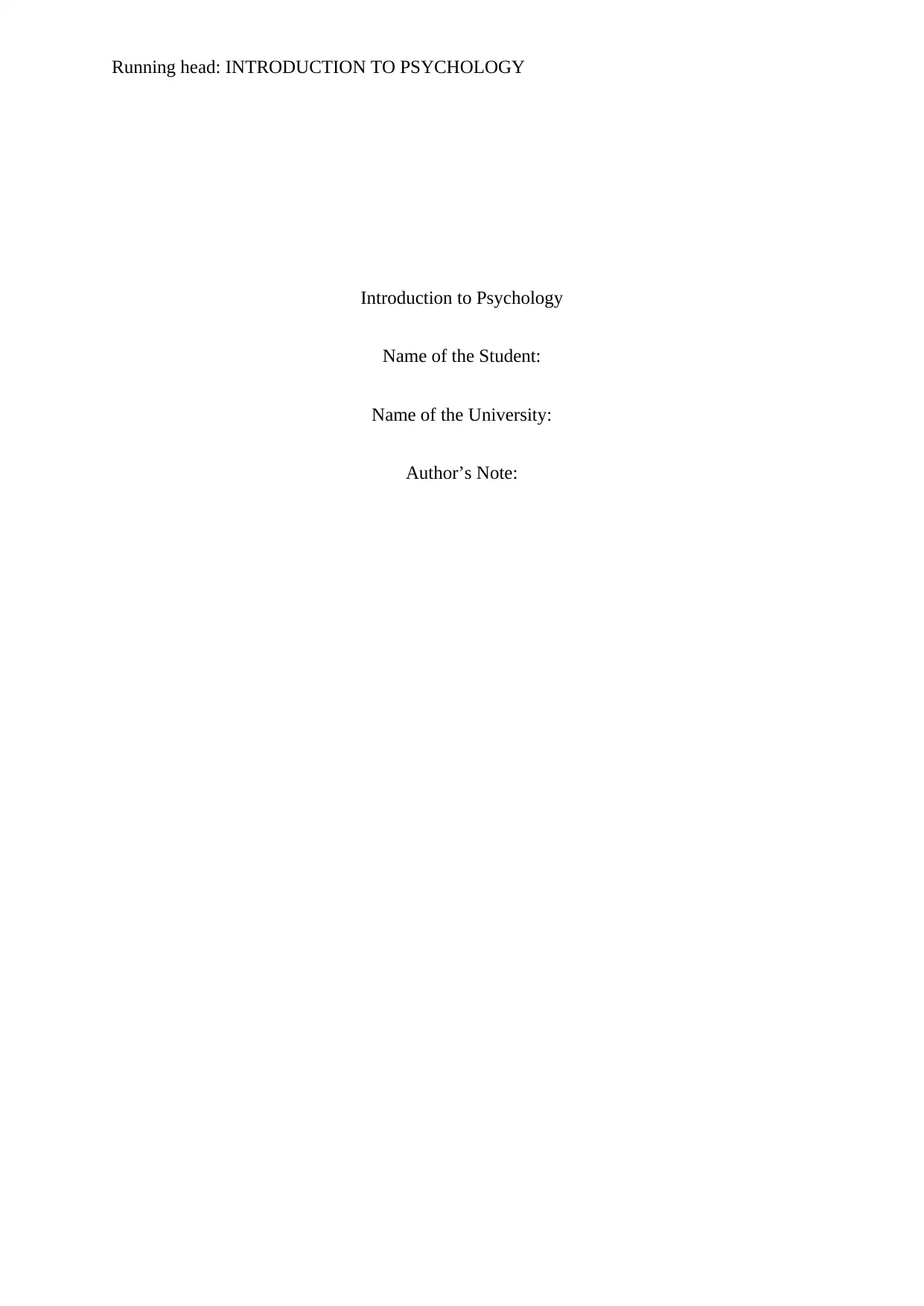
Running head: INTRODUCTION TO PSYCHOLOGY
Introduction to Psychology
Name of the Student:
Name of the University:
Author’s Note:
Introduction to Psychology
Name of the Student:
Name of the University:
Author’s Note:
Secure Best Marks with AI Grader
Need help grading? Try our AI Grader for instant feedback on your assignments.
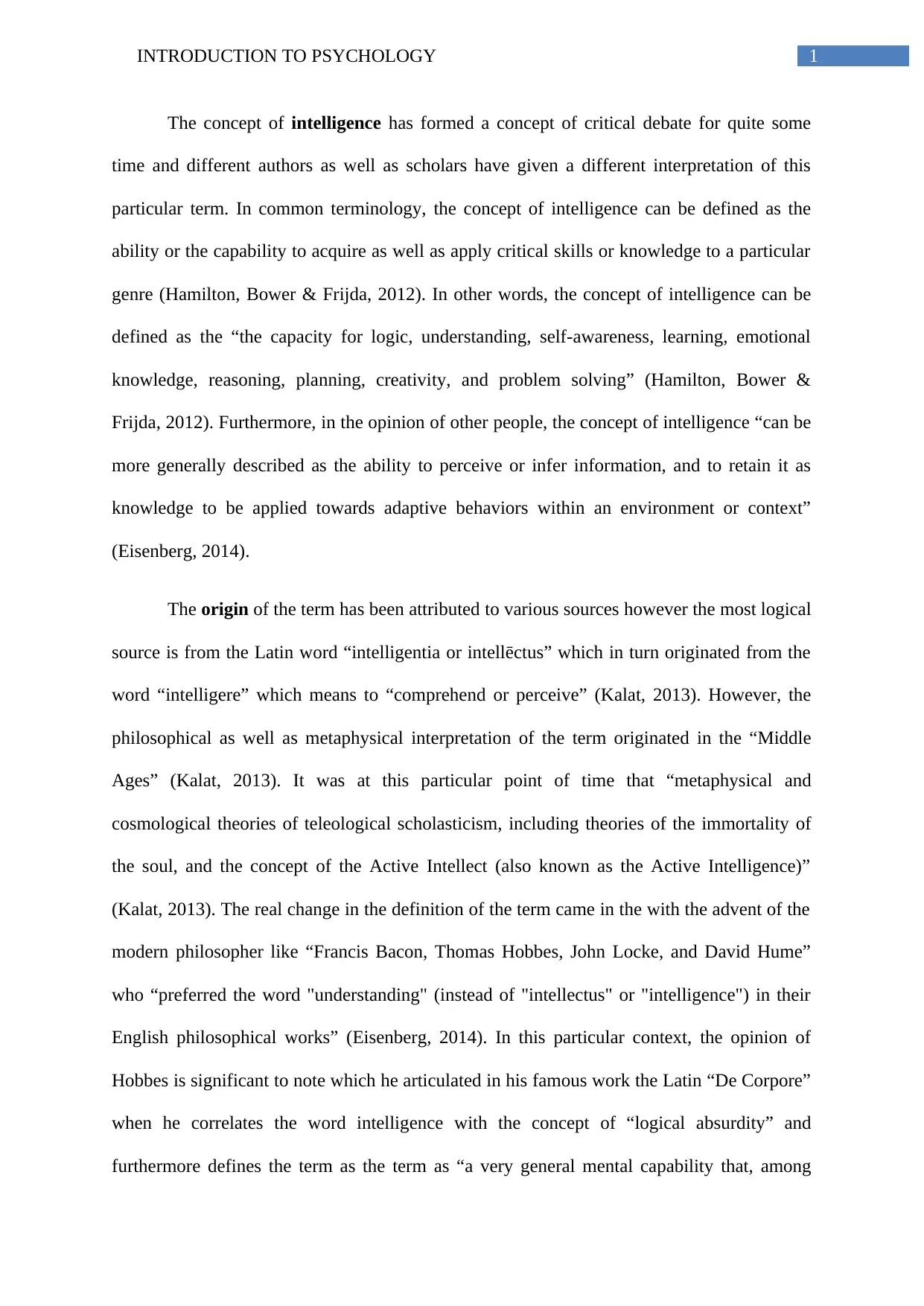
1INTRODUCTION TO PSYCHOLOGY
The concept of intelligence has formed a concept of critical debate for quite some
time and different authors as well as scholars have given a different interpretation of this
particular term. In common terminology, the concept of intelligence can be defined as the
ability or the capability to acquire as well as apply critical skills or knowledge to a particular
genre (Hamilton, Bower & Frijda, 2012). In other words, the concept of intelligence can be
defined as the “the capacity for logic, understanding, self-awareness, learning, emotional
knowledge, reasoning, planning, creativity, and problem solving” (Hamilton, Bower &
Frijda, 2012). Furthermore, in the opinion of other people, the concept of intelligence “can be
more generally described as the ability to perceive or infer information, and to retain it as
knowledge to be applied towards adaptive behaviors within an environment or context”
(Eisenberg, 2014).
The origin of the term has been attributed to various sources however the most logical
source is from the Latin word “intelligentia or intellēctus” which in turn originated from the
word “intelligere” which means to “comprehend or perceive” (Kalat, 2013). However, the
philosophical as well as metaphysical interpretation of the term originated in the “Middle
Ages” (Kalat, 2013). It was at this particular point of time that “metaphysical and
cosmological theories of teleological scholasticism, including theories of the immortality of
the soul, and the concept of the Active Intellect (also known as the Active Intelligence)”
(Kalat, 2013). The real change in the definition of the term came in the with the advent of the
modern philosopher like “Francis Bacon, Thomas Hobbes, John Locke, and David Hume”
who “preferred the word "understanding" (instead of "intellectus" or "intelligence") in their
English philosophical works” (Eisenberg, 2014). In this particular context, the opinion of
Hobbes is significant to note which he articulated in his famous work the Latin “De Corpore”
when he correlates the word intelligence with the concept of “logical absurdity” and
furthermore defines the term as the term as “a very general mental capability that, among
The concept of intelligence has formed a concept of critical debate for quite some
time and different authors as well as scholars have given a different interpretation of this
particular term. In common terminology, the concept of intelligence can be defined as the
ability or the capability to acquire as well as apply critical skills or knowledge to a particular
genre (Hamilton, Bower & Frijda, 2012). In other words, the concept of intelligence can be
defined as the “the capacity for logic, understanding, self-awareness, learning, emotional
knowledge, reasoning, planning, creativity, and problem solving” (Hamilton, Bower &
Frijda, 2012). Furthermore, in the opinion of other people, the concept of intelligence “can be
more generally described as the ability to perceive or infer information, and to retain it as
knowledge to be applied towards adaptive behaviors within an environment or context”
(Eisenberg, 2014).
The origin of the term has been attributed to various sources however the most logical
source is from the Latin word “intelligentia or intellēctus” which in turn originated from the
word “intelligere” which means to “comprehend or perceive” (Kalat, 2013). However, the
philosophical as well as metaphysical interpretation of the term originated in the “Middle
Ages” (Kalat, 2013). It was at this particular point of time that “metaphysical and
cosmological theories of teleological scholasticism, including theories of the immortality of
the soul, and the concept of the Active Intellect (also known as the Active Intelligence)”
(Kalat, 2013). The real change in the definition of the term came in the with the advent of the
modern philosopher like “Francis Bacon, Thomas Hobbes, John Locke, and David Hume”
who “preferred the word "understanding" (instead of "intellectus" or "intelligence") in their
English philosophical works” (Eisenberg, 2014). In this particular context, the opinion of
Hobbes is significant to note which he articulated in his famous work the Latin “De Corpore”
when he correlates the word intelligence with the concept of “logical absurdity” and
furthermore defines the term as the term as “a very general mental capability that, among

2INTRODUCTION TO PSYCHOLOGY
other things, involves the ability to reason, plan, solve problems, think abstractly,
comprehend complex ideas, learn quickly and learn from experience (Coon & Mitterer,
2012). It is not merely book learning, a narrow academic skill, or test-taking smarts. Rather, it
reflects a broader and deeper capability for comprehending our surroundings—"catching on,"
"making sense" of things, or "figuring out" what to do” (Coon & Mitterer, 2012).
This particular concept has a special relevance to me as being a student I have often
wondered about the factors which influence the intelligence of the individuals and also the
reason why some people are more intelligent than the others. Furthermore, I would also like
to add here that the modern connation of the term has also drawn my attention towards this
particular concept in a significant manner. It is significant to note that in the present day the
concept is not only meant to define the ability or the capability of an individual to learn a new
thing or complete a particular job but it has attained a much broader connotation (Russell &
Norvig, 2016). In the modern day field of psychology the concept is used to determine the
“different mental abilities including logic, reasoning, problem-solving, and planning”
(Russell & Norvig, 2016). Thus, it helps me to get an overview of these concepts which I
found as common attributes in the world around myself. Furthermore, the concept of
intelligence and the various related theories also helps me to understand the rationale as well
as the point of view of the various individuals and also helps me to from a basic idea of the
person with whom I am dealing with by their reasoning pattern or logical abilities (Russell &
Norvig, 2016).
To conclude, from the above discussion it becomes clear that the concept of
intelligence is a very dynamic one and has undergone much transformation in the recent
times. In the recent times, it is seen that the concept has attained a philosophical as well as
psychological dimension. It is significant to note that although in the initial days the concept
was totally a biological one however in the present times the concept has attained both
other things, involves the ability to reason, plan, solve problems, think abstractly,
comprehend complex ideas, learn quickly and learn from experience (Coon & Mitterer,
2012). It is not merely book learning, a narrow academic skill, or test-taking smarts. Rather, it
reflects a broader and deeper capability for comprehending our surroundings—"catching on,"
"making sense" of things, or "figuring out" what to do” (Coon & Mitterer, 2012).
This particular concept has a special relevance to me as being a student I have often
wondered about the factors which influence the intelligence of the individuals and also the
reason why some people are more intelligent than the others. Furthermore, I would also like
to add here that the modern connation of the term has also drawn my attention towards this
particular concept in a significant manner. It is significant to note that in the present day the
concept is not only meant to define the ability or the capability of an individual to learn a new
thing or complete a particular job but it has attained a much broader connotation (Russell &
Norvig, 2016). In the modern day field of psychology the concept is used to determine the
“different mental abilities including logic, reasoning, problem-solving, and planning”
(Russell & Norvig, 2016). Thus, it helps me to get an overview of these concepts which I
found as common attributes in the world around myself. Furthermore, the concept of
intelligence and the various related theories also helps me to understand the rationale as well
as the point of view of the various individuals and also helps me to from a basic idea of the
person with whom I am dealing with by their reasoning pattern or logical abilities (Russell &
Norvig, 2016).
To conclude, from the above discussion it becomes clear that the concept of
intelligence is a very dynamic one and has undergone much transformation in the recent
times. In the recent times, it is seen that the concept has attained a philosophical as well as
psychological dimension. It is significant to note that although in the initial days the concept
was totally a biological one however in the present times the concept has attained both
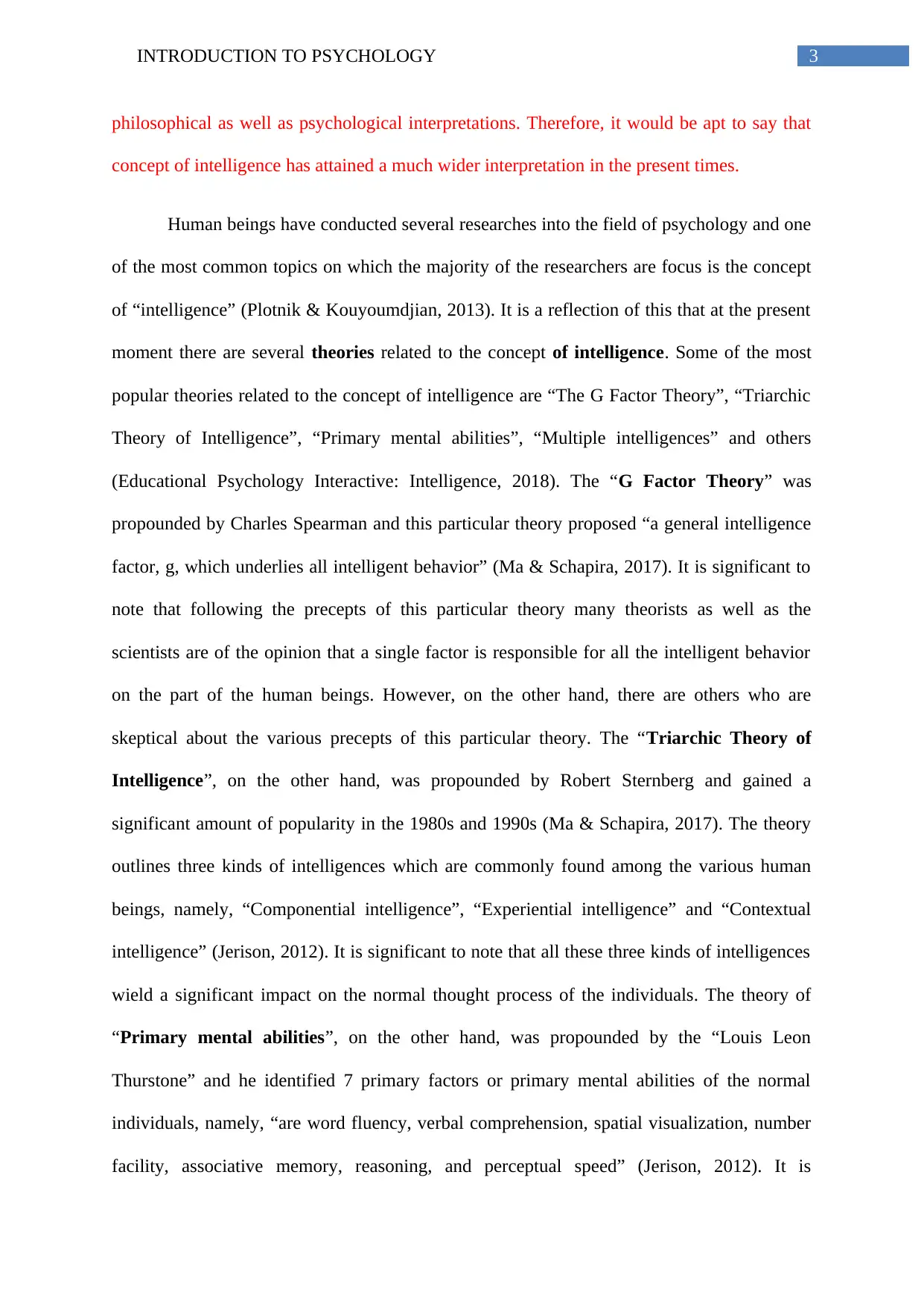
3INTRODUCTION TO PSYCHOLOGY
philosophical as well as psychological interpretations. Therefore, it would be apt to say that
concept of intelligence has attained a much wider interpretation in the present times.
Human beings have conducted several researches into the field of psychology and one
of the most common topics on which the majority of the researchers are focus is the concept
of “intelligence” (Plotnik & Kouyoumdjian, 2013). It is a reflection of this that at the present
moment there are several theories related to the concept of intelligence. Some of the most
popular theories related to the concept of intelligence are “The G Factor Theory”, “Triarchic
Theory of Intelligence”, “Primary mental abilities”, “Multiple intelligences” and others
(Educational Psychology Interactive: Intelligence, 2018). The “G Factor Theory” was
propounded by Charles Spearman and this particular theory proposed “a general intelligence
factor, g, which underlies all intelligent behavior” (Ma & Schapira, 2017). It is significant to
note that following the precepts of this particular theory many theorists as well as the
scientists are of the opinion that a single factor is responsible for all the intelligent behavior
on the part of the human beings. However, on the other hand, there are others who are
skeptical about the various precepts of this particular theory. The “Triarchic Theory of
Intelligence”, on the other hand, was propounded by Robert Sternberg and gained a
significant amount of popularity in the 1980s and 1990s (Ma & Schapira, 2017). The theory
outlines three kinds of intelligences which are commonly found among the various human
beings, namely, “Componential intelligence”, “Experiential intelligence” and “Contextual
intelligence” (Jerison, 2012). It is significant to note that all these three kinds of intelligences
wield a significant impact on the normal thought process of the individuals. The theory of
“Primary mental abilities”, on the other hand, was propounded by the “Louis Leon
Thurstone” and he identified 7 primary factors or primary mental abilities of the normal
individuals, namely, “are word fluency, verbal comprehension, spatial visualization, number
facility, associative memory, reasoning, and perceptual speed” (Jerison, 2012). It is
philosophical as well as psychological interpretations. Therefore, it would be apt to say that
concept of intelligence has attained a much wider interpretation in the present times.
Human beings have conducted several researches into the field of psychology and one
of the most common topics on which the majority of the researchers are focus is the concept
of “intelligence” (Plotnik & Kouyoumdjian, 2013). It is a reflection of this that at the present
moment there are several theories related to the concept of intelligence. Some of the most
popular theories related to the concept of intelligence are “The G Factor Theory”, “Triarchic
Theory of Intelligence”, “Primary mental abilities”, “Multiple intelligences” and others
(Educational Psychology Interactive: Intelligence, 2018). The “G Factor Theory” was
propounded by Charles Spearman and this particular theory proposed “a general intelligence
factor, g, which underlies all intelligent behavior” (Ma & Schapira, 2017). It is significant to
note that following the precepts of this particular theory many theorists as well as the
scientists are of the opinion that a single factor is responsible for all the intelligent behavior
on the part of the human beings. However, on the other hand, there are others who are
skeptical about the various precepts of this particular theory. The “Triarchic Theory of
Intelligence”, on the other hand, was propounded by Robert Sternberg and gained a
significant amount of popularity in the 1980s and 1990s (Ma & Schapira, 2017). The theory
outlines three kinds of intelligences which are commonly found among the various human
beings, namely, “Componential intelligence”, “Experiential intelligence” and “Contextual
intelligence” (Jerison, 2012). It is significant to note that all these three kinds of intelligences
wield a significant impact on the normal thought process of the individuals. The theory of
“Primary mental abilities”, on the other hand, was propounded by the “Louis Leon
Thurstone” and he identified 7 primary factors or primary mental abilities of the normal
individuals, namely, “are word fluency, verbal comprehension, spatial visualization, number
facility, associative memory, reasoning, and perceptual speed” (Jerison, 2012). It is
Paraphrase This Document
Need a fresh take? Get an instant paraphrase of this document with our AI Paraphraser
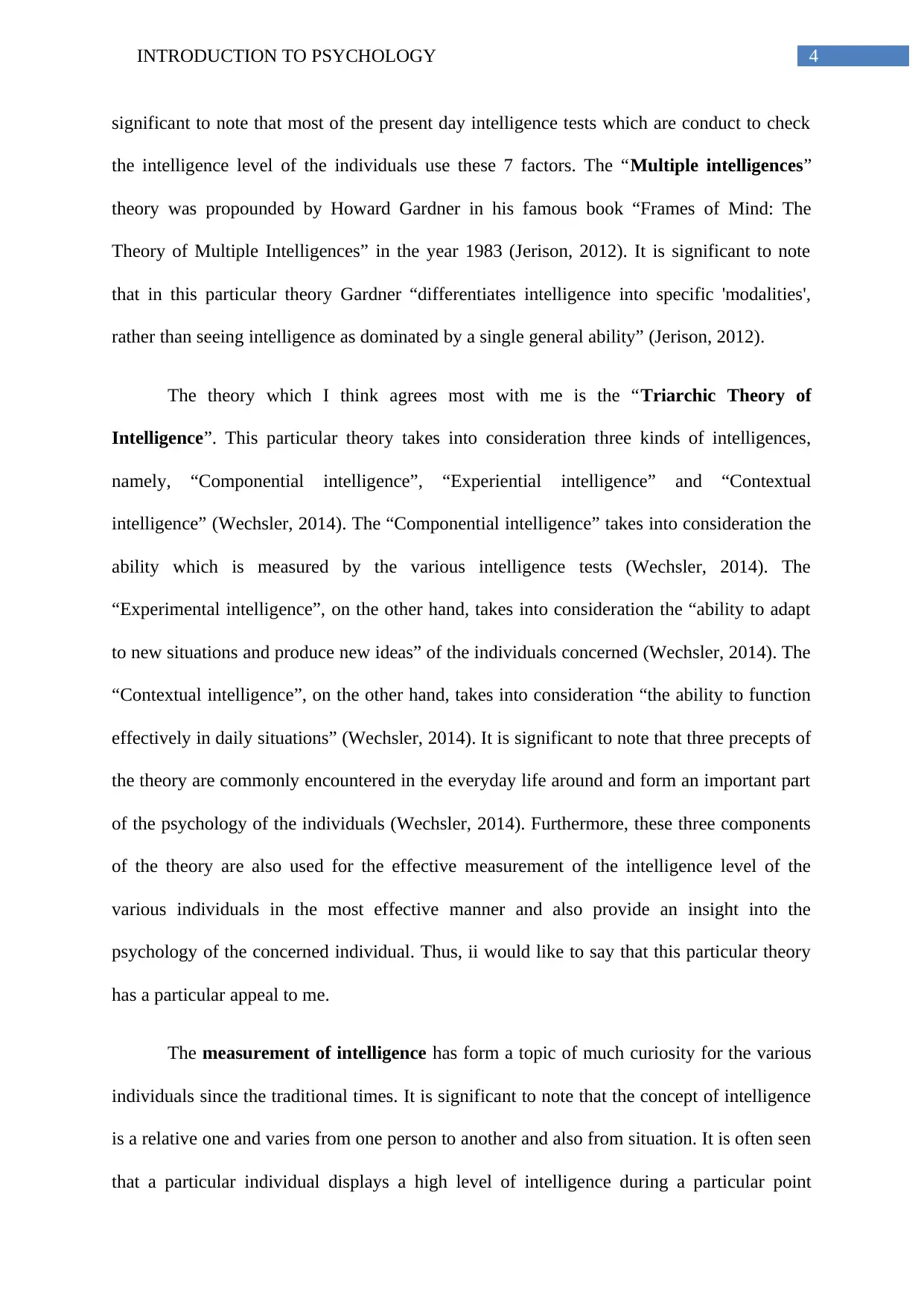
4INTRODUCTION TO PSYCHOLOGY
significant to note that most of the present day intelligence tests which are conduct to check
the intelligence level of the individuals use these 7 factors. The “Multiple intelligences”
theory was propounded by Howard Gardner in his famous book “Frames of Mind: The
Theory of Multiple Intelligences” in the year 1983 (Jerison, 2012). It is significant to note
that in this particular theory Gardner “differentiates intelligence into specific 'modalities',
rather than seeing intelligence as dominated by a single general ability” (Jerison, 2012).
The theory which I think agrees most with me is the “Triarchic Theory of
Intelligence”. This particular theory takes into consideration three kinds of intelligences,
namely, “Componential intelligence”, “Experiential intelligence” and “Contextual
intelligence” (Wechsler, 2014). The “Componential intelligence” takes into consideration the
ability which is measured by the various intelligence tests (Wechsler, 2014). The
“Experimental intelligence”, on the other hand, takes into consideration the “ability to adapt
to new situations and produce new ideas” of the individuals concerned (Wechsler, 2014). The
“Contextual intelligence”, on the other hand, takes into consideration “the ability to function
effectively in daily situations” (Wechsler, 2014). It is significant to note that three precepts of
the theory are commonly encountered in the everyday life around and form an important part
of the psychology of the individuals (Wechsler, 2014). Furthermore, these three components
of the theory are also used for the effective measurement of the intelligence level of the
various individuals in the most effective manner and also provide an insight into the
psychology of the concerned individual. Thus, ii would like to say that this particular theory
has a particular appeal to me.
The measurement of intelligence has form a topic of much curiosity for the various
individuals since the traditional times. It is significant to note that the concept of intelligence
is a relative one and varies from one person to another and also from situation. It is often seen
that a particular individual displays a high level of intelligence during a particular point
significant to note that most of the present day intelligence tests which are conduct to check
the intelligence level of the individuals use these 7 factors. The “Multiple intelligences”
theory was propounded by Howard Gardner in his famous book “Frames of Mind: The
Theory of Multiple Intelligences” in the year 1983 (Jerison, 2012). It is significant to note
that in this particular theory Gardner “differentiates intelligence into specific 'modalities',
rather than seeing intelligence as dominated by a single general ability” (Jerison, 2012).
The theory which I think agrees most with me is the “Triarchic Theory of
Intelligence”. This particular theory takes into consideration three kinds of intelligences,
namely, “Componential intelligence”, “Experiential intelligence” and “Contextual
intelligence” (Wechsler, 2014). The “Componential intelligence” takes into consideration the
ability which is measured by the various intelligence tests (Wechsler, 2014). The
“Experimental intelligence”, on the other hand, takes into consideration the “ability to adapt
to new situations and produce new ideas” of the individuals concerned (Wechsler, 2014). The
“Contextual intelligence”, on the other hand, takes into consideration “the ability to function
effectively in daily situations” (Wechsler, 2014). It is significant to note that three precepts of
the theory are commonly encountered in the everyday life around and form an important part
of the psychology of the individuals (Wechsler, 2014). Furthermore, these three components
of the theory are also used for the effective measurement of the intelligence level of the
various individuals in the most effective manner and also provide an insight into the
psychology of the concerned individual. Thus, ii would like to say that this particular theory
has a particular appeal to me.
The measurement of intelligence has form a topic of much curiosity for the various
individuals since the traditional times. It is significant to note that the concept of intelligence
is a relative one and varies from one person to another and also from situation. It is often seen
that a particular individual displays a high level of intelligence during a particular point
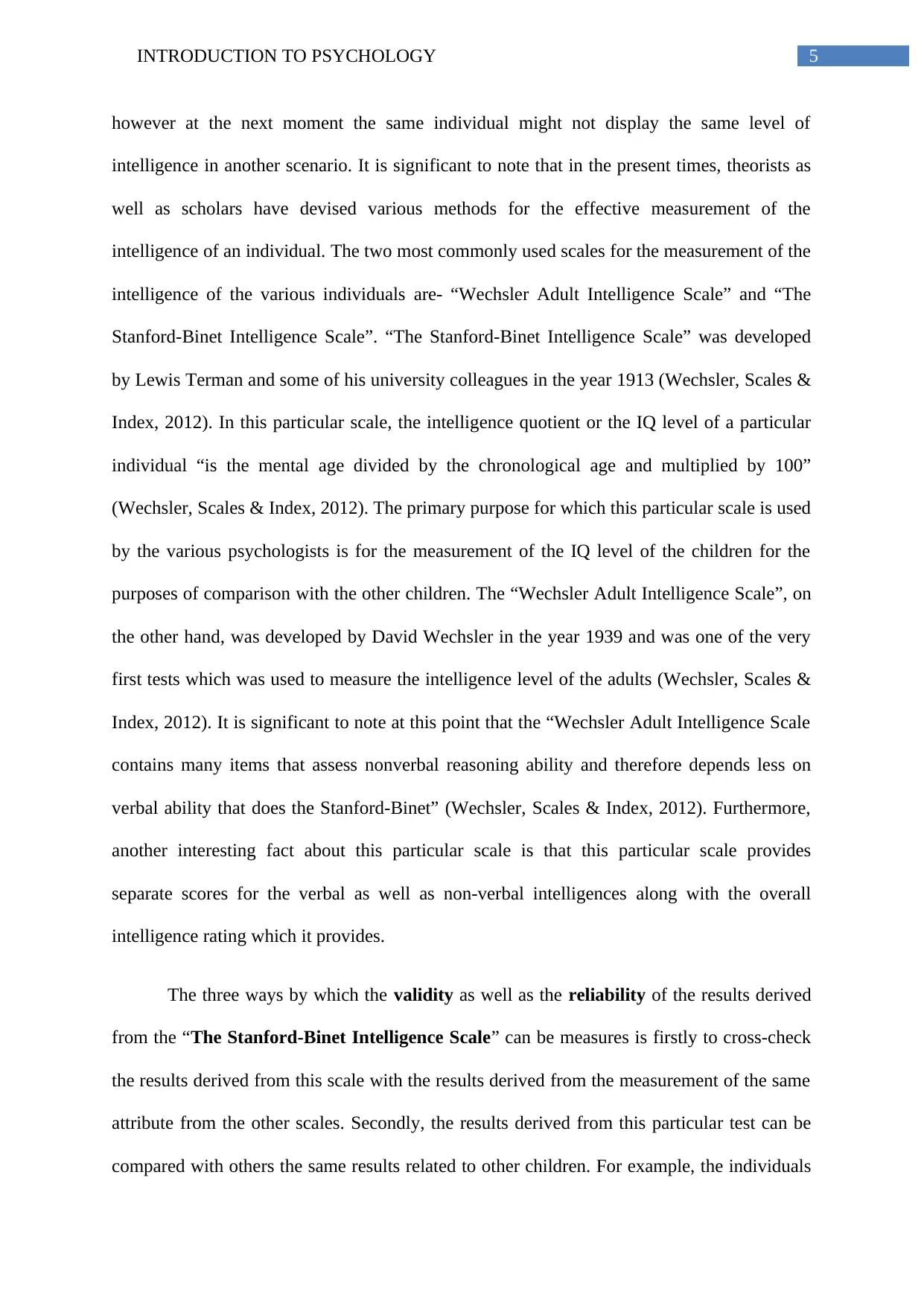
5INTRODUCTION TO PSYCHOLOGY
however at the next moment the same individual might not display the same level of
intelligence in another scenario. It is significant to note that in the present times, theorists as
well as scholars have devised various methods for the effective measurement of the
intelligence of an individual. The two most commonly used scales for the measurement of the
intelligence of the various individuals are- “Wechsler Adult Intelligence Scale” and “The
Stanford-Binet Intelligence Scale”. “The Stanford-Binet Intelligence Scale” was developed
by Lewis Terman and some of his university colleagues in the year 1913 (Wechsler, Scales &
Index, 2012). In this particular scale, the intelligence quotient or the IQ level of a particular
individual “is the mental age divided by the chronological age and multiplied by 100”
(Wechsler, Scales & Index, 2012). The primary purpose for which this particular scale is used
by the various psychologists is for the measurement of the IQ level of the children for the
purposes of comparison with the other children. The “Wechsler Adult Intelligence Scale”, on
the other hand, was developed by David Wechsler in the year 1939 and was one of the very
first tests which was used to measure the intelligence level of the adults (Wechsler, Scales &
Index, 2012). It is significant to note at this point that the “Wechsler Adult Intelligence Scale
contains many items that assess nonverbal reasoning ability and therefore depends less on
verbal ability that does the Stanford-Binet” (Wechsler, Scales & Index, 2012). Furthermore,
another interesting fact about this particular scale is that this particular scale provides
separate scores for the verbal as well as non-verbal intelligences along with the overall
intelligence rating which it provides.
The three ways by which the validity as well as the reliability of the results derived
from the “The Stanford-Binet Intelligence Scale” can be measures is firstly to cross-check
the results derived from this scale with the results derived from the measurement of the same
attribute from the other scales. Secondly, the results derived from this particular test can be
compared with others the same results related to other children. For example, the individuals
however at the next moment the same individual might not display the same level of
intelligence in another scenario. It is significant to note that in the present times, theorists as
well as scholars have devised various methods for the effective measurement of the
intelligence of an individual. The two most commonly used scales for the measurement of the
intelligence of the various individuals are- “Wechsler Adult Intelligence Scale” and “The
Stanford-Binet Intelligence Scale”. “The Stanford-Binet Intelligence Scale” was developed
by Lewis Terman and some of his university colleagues in the year 1913 (Wechsler, Scales &
Index, 2012). In this particular scale, the intelligence quotient or the IQ level of a particular
individual “is the mental age divided by the chronological age and multiplied by 100”
(Wechsler, Scales & Index, 2012). The primary purpose for which this particular scale is used
by the various psychologists is for the measurement of the IQ level of the children for the
purposes of comparison with the other children. The “Wechsler Adult Intelligence Scale”, on
the other hand, was developed by David Wechsler in the year 1939 and was one of the very
first tests which was used to measure the intelligence level of the adults (Wechsler, Scales &
Index, 2012). It is significant to note at this point that the “Wechsler Adult Intelligence Scale
contains many items that assess nonverbal reasoning ability and therefore depends less on
verbal ability that does the Stanford-Binet” (Wechsler, Scales & Index, 2012). Furthermore,
another interesting fact about this particular scale is that this particular scale provides
separate scores for the verbal as well as non-verbal intelligences along with the overall
intelligence rating which it provides.
The three ways by which the validity as well as the reliability of the results derived
from the “The Stanford-Binet Intelligence Scale” can be measures is firstly to cross-check
the results derived from this scale with the results derived from the measurement of the same
attribute from the other scales. Secondly, the results derived from this particular test can be
compared with others the same results related to other children. For example, the individuals
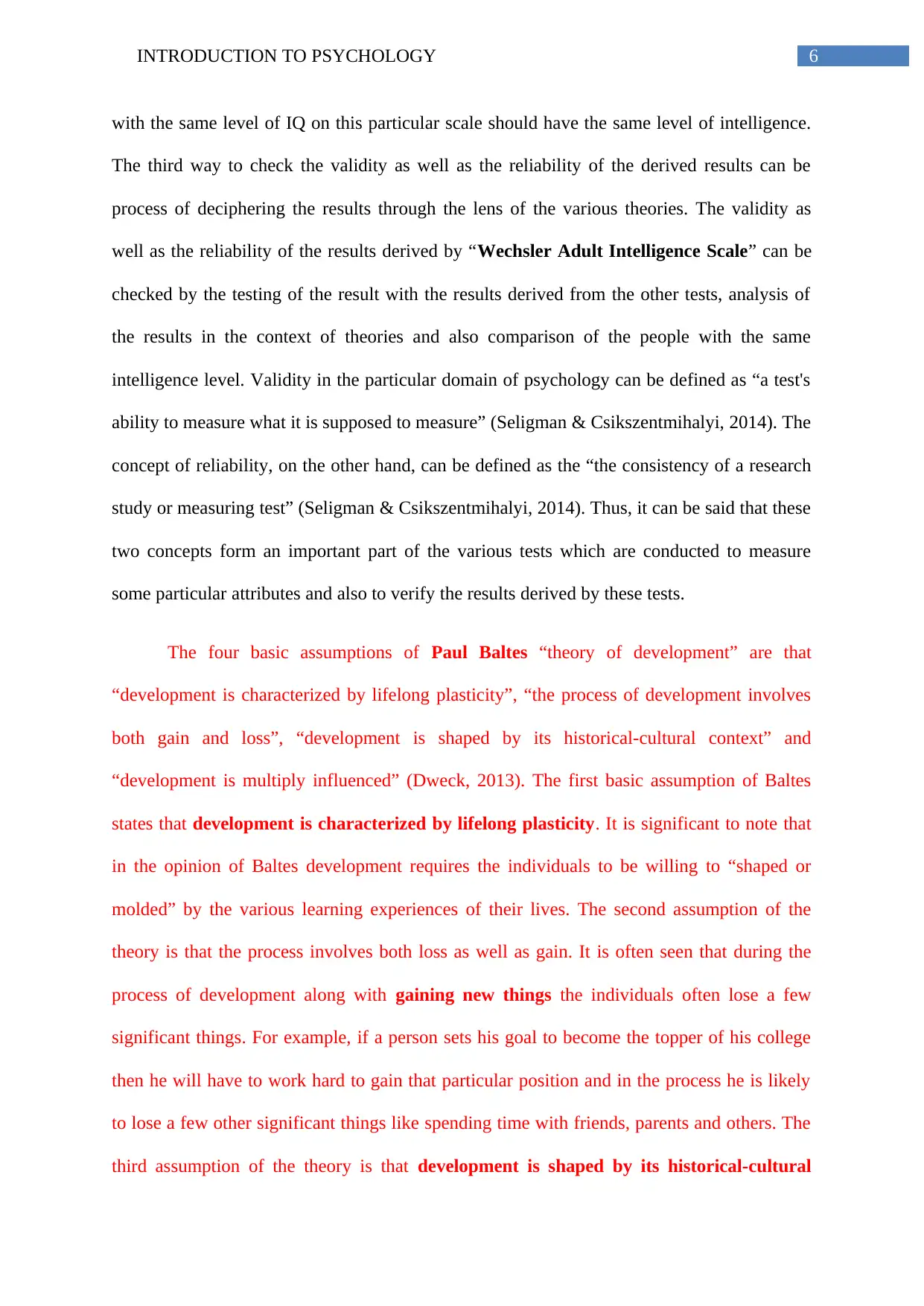
6INTRODUCTION TO PSYCHOLOGY
with the same level of IQ on this particular scale should have the same level of intelligence.
The third way to check the validity as well as the reliability of the derived results can be
process of deciphering the results through the lens of the various theories. The validity as
well as the reliability of the results derived by “Wechsler Adult Intelligence Scale” can be
checked by the testing of the result with the results derived from the other tests, analysis of
the results in the context of theories and also comparison of the people with the same
intelligence level. Validity in the particular domain of psychology can be defined as “a test's
ability to measure what it is supposed to measure” (Seligman & Csikszentmihalyi, 2014). The
concept of reliability, on the other hand, can be defined as the “the consistency of a research
study or measuring test” (Seligman & Csikszentmihalyi, 2014). Thus, it can be said that these
two concepts form an important part of the various tests which are conducted to measure
some particular attributes and also to verify the results derived by these tests.
The four basic assumptions of Paul Baltes “theory of development” are that
“development is characterized by lifelong plasticity”, “the process of development involves
both gain and loss”, “development is shaped by its historical-cultural context” and
“development is multiply influenced” (Dweck, 2013). The first basic assumption of Baltes
states that development is characterized by lifelong plasticity. It is significant to note that
in the opinion of Baltes development requires the individuals to be willing to “shaped or
molded” by the various learning experiences of their lives. The second assumption of the
theory is that the process involves both loss as well as gain. It is often seen that during the
process of development along with gaining new things the individuals often lose a few
significant things. For example, if a person sets his goal to become the topper of his college
then he will have to work hard to gain that particular position and in the process he is likely
to lose a few other significant things like spending time with friends, parents and others. The
third assumption of the theory is that development is shaped by its historical-cultural
with the same level of IQ on this particular scale should have the same level of intelligence.
The third way to check the validity as well as the reliability of the derived results can be
process of deciphering the results through the lens of the various theories. The validity as
well as the reliability of the results derived by “Wechsler Adult Intelligence Scale” can be
checked by the testing of the result with the results derived from the other tests, analysis of
the results in the context of theories and also comparison of the people with the same
intelligence level. Validity in the particular domain of psychology can be defined as “a test's
ability to measure what it is supposed to measure” (Seligman & Csikszentmihalyi, 2014). The
concept of reliability, on the other hand, can be defined as the “the consistency of a research
study or measuring test” (Seligman & Csikszentmihalyi, 2014). Thus, it can be said that these
two concepts form an important part of the various tests which are conducted to measure
some particular attributes and also to verify the results derived by these tests.
The four basic assumptions of Paul Baltes “theory of development” are that
“development is characterized by lifelong plasticity”, “the process of development involves
both gain and loss”, “development is shaped by its historical-cultural context” and
“development is multiply influenced” (Dweck, 2013). The first basic assumption of Baltes
states that development is characterized by lifelong plasticity. It is significant to note that
in the opinion of Baltes development requires the individuals to be willing to “shaped or
molded” by the various learning experiences of their lives. The second assumption of the
theory is that the process involves both loss as well as gain. It is often seen that during the
process of development along with gaining new things the individuals often lose a few
significant things. For example, if a person sets his goal to become the topper of his college
then he will have to work hard to gain that particular position and in the process he is likely
to lose a few other significant things like spending time with friends, parents and others. The
third assumption of the theory is that development is shaped by its historical-cultural
Secure Best Marks with AI Grader
Need help grading? Try our AI Grader for instant feedback on your assignments.
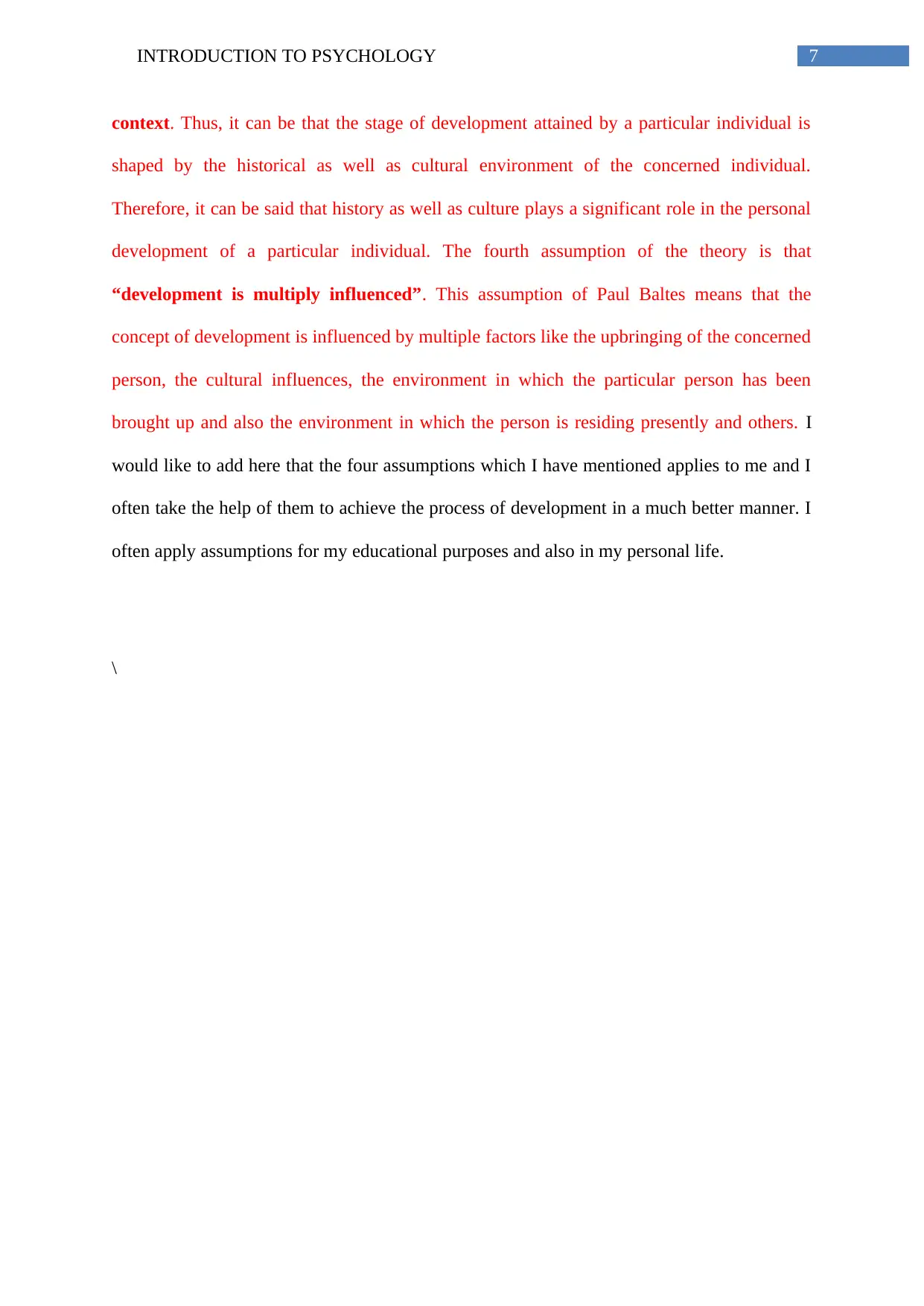
7INTRODUCTION TO PSYCHOLOGY
context. Thus, it can be that the stage of development attained by a particular individual is
shaped by the historical as well as cultural environment of the concerned individual.
Therefore, it can be said that history as well as culture plays a significant role in the personal
development of a particular individual. The fourth assumption of the theory is that
“development is multiply influenced”. This assumption of Paul Baltes means that the
concept of development is influenced by multiple factors like the upbringing of the concerned
person, the cultural influences, the environment in which the particular person has been
brought up and also the environment in which the person is residing presently and others. I
would like to add here that the four assumptions which I have mentioned applies to me and I
often take the help of them to achieve the process of development in a much better manner. I
often apply assumptions for my educational purposes and also in my personal life.
\
context. Thus, it can be that the stage of development attained by a particular individual is
shaped by the historical as well as cultural environment of the concerned individual.
Therefore, it can be said that history as well as culture plays a significant role in the personal
development of a particular individual. The fourth assumption of the theory is that
“development is multiply influenced”. This assumption of Paul Baltes means that the
concept of development is influenced by multiple factors like the upbringing of the concerned
person, the cultural influences, the environment in which the particular person has been
brought up and also the environment in which the person is residing presently and others. I
would like to add here that the four assumptions which I have mentioned applies to me and I
often take the help of them to achieve the process of development in a much better manner. I
often apply assumptions for my educational purposes and also in my personal life.
\

8INTRODUCTION TO PSYCHOLOGY
References
Coon, D., & Mitterer, J. O. (2012). Introduction to psychology: Gateways to mind and
behavior with concept maps and reviews. Cengage Learning.
Dweck, C. S. (2013). Self-theories: Their role in motivation, personality, and development.
psychology press.
Educational Psychology Interactive: Intelligence. (2018). Edpsycinteractive.org. Retrieved
12 April 2018, from http://www.edpsycinteractive.org/topics/cognition/intell.html
Eisenberg, N. (2014). Altruistic emotion, cognition, and behavior (PLE: Emotion).
Psychology Press.
Hamilton, V., Bower, G. H., & Frijda, N. H. (Eds.). (2012). Cognitive perspectives on
emotion and motivation (Vol. 44). Springer Science & Business Media.
Jerison, H. (2012). Evolution of the brain and intelligence. Elsevier.
Kalat, J. W. (2013). Introduction to psychology. Cengage Learning.
Ma, C., & Schapira, M. (2017). The bell curve: Intelligence and class structure in American
life. Macat Library.
Plotnik, R., & Kouyoumdjian, H. (2013). Introduction to psychology. Cengage Learning.
Russell, S. J., & Norvig, P. (2016). Artificial intelligence: a modern approach. Malaysia;
Pearson Education Limited,.
Seligman, M. E., & Csikszentmihalyi, M. (2014). Positive psychology: An introduction.
In Flow and the foundations of positive psychology (pp. 279-298). Springer Netherlands.
References
Coon, D., & Mitterer, J. O. (2012). Introduction to psychology: Gateways to mind and
behavior with concept maps and reviews. Cengage Learning.
Dweck, C. S. (2013). Self-theories: Their role in motivation, personality, and development.
psychology press.
Educational Psychology Interactive: Intelligence. (2018). Edpsycinteractive.org. Retrieved
12 April 2018, from http://www.edpsycinteractive.org/topics/cognition/intell.html
Eisenberg, N. (2014). Altruistic emotion, cognition, and behavior (PLE: Emotion).
Psychology Press.
Hamilton, V., Bower, G. H., & Frijda, N. H. (Eds.). (2012). Cognitive perspectives on
emotion and motivation (Vol. 44). Springer Science & Business Media.
Jerison, H. (2012). Evolution of the brain and intelligence. Elsevier.
Kalat, J. W. (2013). Introduction to psychology. Cengage Learning.
Ma, C., & Schapira, M. (2017). The bell curve: Intelligence and class structure in American
life. Macat Library.
Plotnik, R., & Kouyoumdjian, H. (2013). Introduction to psychology. Cengage Learning.
Russell, S. J., & Norvig, P. (2016). Artificial intelligence: a modern approach. Malaysia;
Pearson Education Limited,.
Seligman, M. E., & Csikszentmihalyi, M. (2014). Positive psychology: An introduction.
In Flow and the foundations of positive psychology (pp. 279-298). Springer Netherlands.
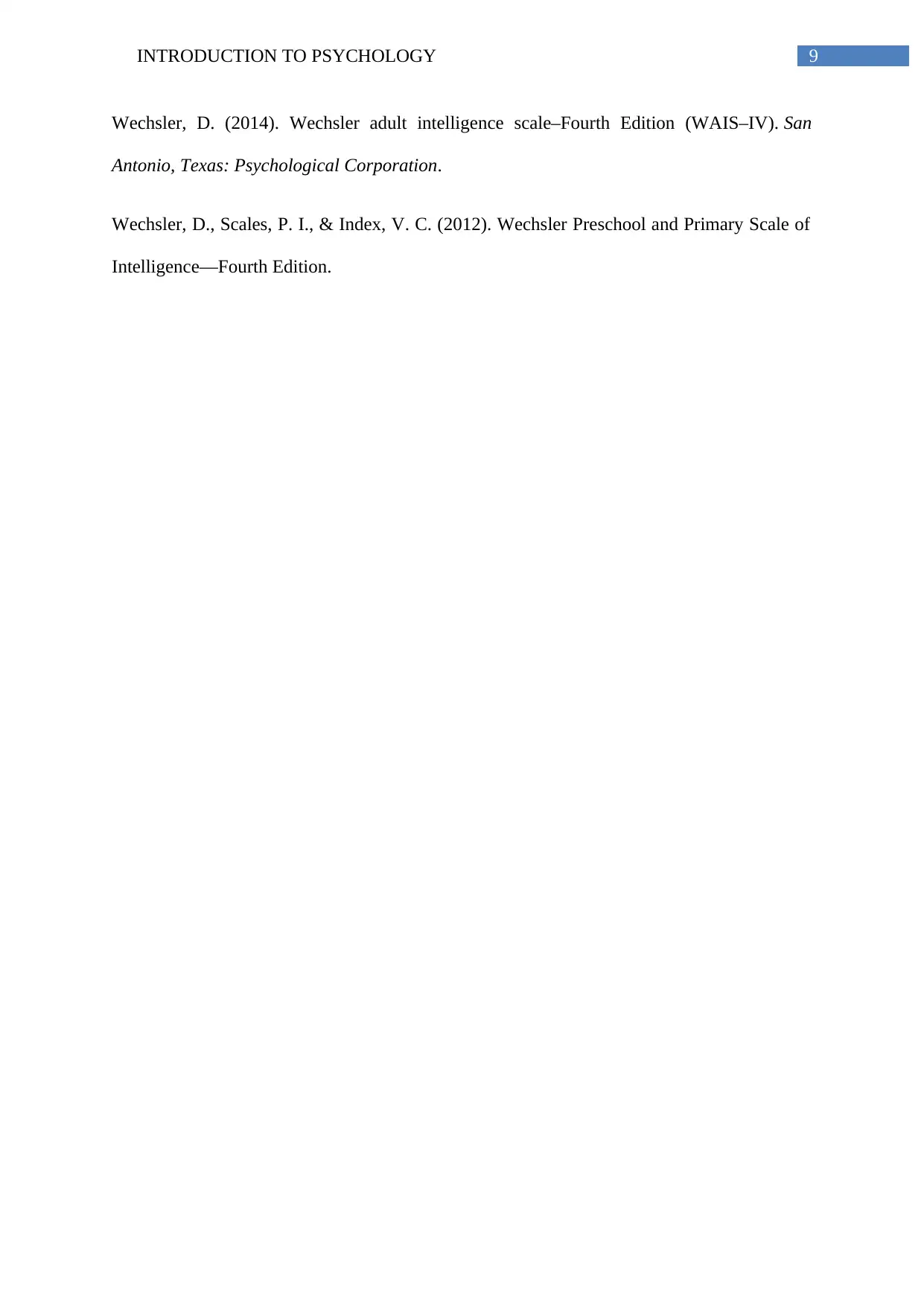
9INTRODUCTION TO PSYCHOLOGY
Wechsler, D. (2014). Wechsler adult intelligence scale–Fourth Edition (WAIS–IV). San
Antonio, Texas: Psychological Corporation.
Wechsler, D., Scales, P. I., & Index, V. C. (2012). Wechsler Preschool and Primary Scale of
Intelligence—Fourth Edition.
Wechsler, D. (2014). Wechsler adult intelligence scale–Fourth Edition (WAIS–IV). San
Antonio, Texas: Psychological Corporation.
Wechsler, D., Scales, P. I., & Index, V. C. (2012). Wechsler Preschool and Primary Scale of
Intelligence—Fourth Edition.
1 out of 10
![[object Object]](/_next/static/media/star-bottom.7253800d.svg)